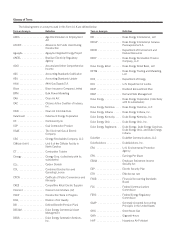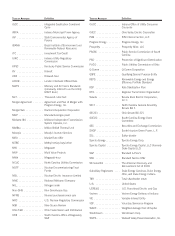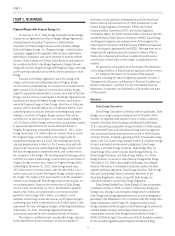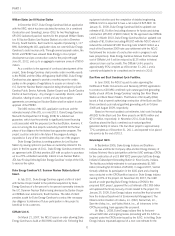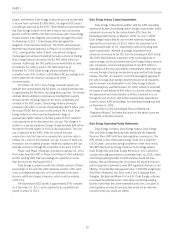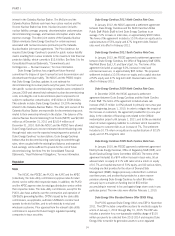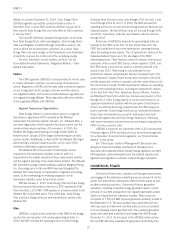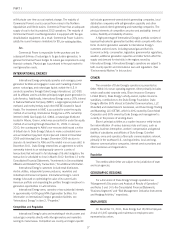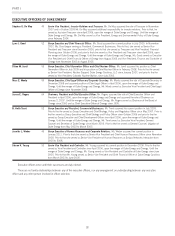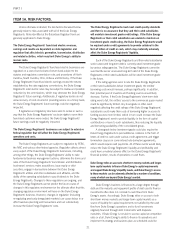Duke Energy 2011 Annual Report Download - page 33
Download and view the complete annual report
Please find page 33 of the 2011 Duke Energy annual report below. You can navigate through the pages in the report by either clicking on the pages listed below, or by using the keyword search tool below to find specific information within the annual report.
PART I
SmartGrid. In response to issues raised by intervenors, Duke Energy
Indiana filed rebuttal testimony agreeing to slow its deployment, and
agreeing to work with the parties collaboratively to design time
differentiated rate and energy management system pilots. During
2009, filings by intervenors and Duke Energy Indiana have been
made that address various issues related to SmartGrid. On April 16,
2010, Duke Energy Indiana filed supplemental testimony in support
of a revised SmartGrid proposal. An evidentiary hearing was held in
July 2010. The IURC issued an order on October 19, 2011,
dismissing the case, without prejudice or consideration of the merits
of the case, due to the substantial delay in adjudication. Duke Energy
will be evaluating its future plans for the demonstration of SmartGrid
technology in Indiana.
Duke Energy Ohio received approval to recover expenditures
incurred to deploy the SmartGrid infrastructure in December 2008 in
conjunction with the approval of Duke Energy Ohio’s ESP filing. In
June 2009, Duke Energy Ohio filed an application to establish rates
for return of its SmartGrid net costs incurred for gas and electric
distribution service through the end of 2008. The rider for recovering
electric SmartGrid costs was approved by the PUCO in its order
approving the ESP. Duke Energy Ohio proposed its gas SmartGrid
rider as part of its most recent gas distribution rate case. A Stipulation
and Recommendation was entered into by Duke Energy Ohio, Staff of
the PUCO, Kroger Company, and Ohio Partners for Affordable
Energy, which provides for a revenue increase of $4.2 million under
the electric rider and $590,000 under the natural gas rider. Approval
of the Stipulation and Recommendation occurred in May 2010.
Duke Energy Ohio filed its application for 2009 cost recovery in July
2010 and a Stipulation and Recommendation was filed on
February 14, 2011, which provides for a revenue requirement
increase of $8.7 million under the electric rider and $5 million under
the gas rider. The PUCO approved the Stipulation on March 23,
2010. On June 30, 2011, Duke Energy Ohio filed its application for
2010 cost recovery. As part of the Stipulation and Recommendation,
Duke Energy Ohio agreed to include a mid-deployment summary and
review with its second quarter 2011 filing outlining its expenditures,
deployment milestones, system performance levels and customer
benefits in comparison to those outlined in the original plan. The
PUCO has also begun an audit of the program, the results of which
will be addressed in the case seeking recovery of 2010 costs.
Duke Energy Business Services was awarded a $200 million
SmartGrid investment grant from the DOE in October 2009. The
original grant application was based on a scaled SmartGrid
deployment in Ohio and Indiana and a distribution automation pilot
in Kentucky. However, due to the regulatory activities in Indiana
described above, the project was re-scoped to include a phased-in
approach in Indiana and additional deployments in Kentucky, North
Carolina and South Carolina. The re-scoped grant was finalized with
the DOE in May 2010. Subsequent to the re-scoping of the grant, as
mentioned above, the IURC denied Duke Energy Indiana’s proposed
SmartGrid pilot without prejudice and Duke Energy Indiana is
currently evaluating its future SmartGrid plans and timing.
Renewable Energy.
Concerns of climate change and energy security, carbon
emissions and a desire to stimulate energy related to economic
development have resulted in rising government support of renewable
energy legislation at both the federal and state level. For example, the
North Carolina legislation (SB 3) established a renewable energy and
energy efficiency portfolio standard (REPS) for electric utilities, and in
2008, the state of Ohio also passed legislation that included
renewable energy and advanced energy targets. With the passage of
Senate Bill 221 (SB 221) in Ohio in 2008, Duke Energy Ohio is
required to secure renewable energy and include an increasing
percentage of renewables as part of its resource portfolio. The
compliance percentages are based on a three-year historical average
of its Standard Service Offer load. The requirements begin at 0.25%
of the baseline load from all renewable resources, including 0.004%
to be specifically from solar beginning in 2009, increasing to 12.5%
total renewable, with 0.5% from solar by 2024. Of these
percentages, at least 50% of each resource type must come from
resources located within the state of Ohio. To address this legislation,
Duke Energy Ohio initiated several acquisition activities focused on
meeting the specific near-term 2009, 2010 and 2011 requirements.
Effective December 10, 2009, the PUCO adopted a set of reporting
standards known as “Green Rules” which will regulate energy
efficiency, alternative energy generation requirements and emission
reporting for activities mandated by SB 221.
The North Carolina REPS was enacted in 2007 as part of SB 3
and became effective January 1, 2008. SB 3 requires that renewable
energy must equal 0.02% of retail sales beginning in 2010 and
increases to 12.5% by 2021. A portion of the requirement may be
met through energy efficiency programs (less than 25% until 2020
and less than 40% thereafter). A portion may also be met through
purchases of unbundled out-of-state renewable energy credits (less
than 25%). Duke Energy Carolinas recovers the majority of costs
associated with renewable compliance through rate rider regulatory
recovery; these costs apply only to North Carolina customers. REPS
rider charges are statutorily capped in order to limit the impact of
renewable compliance costs on customers and spending beyond the
cost cap is not required.
The Indiana state legislature passed Senate Bill 251 in 2011,
establishing a Voluntary Portfolio Standard. IURC rulemaking is
underway with final rules expected mid-2012.
Duke Energy Carolinas expects to be deemed in full compliance
with these requirements in 2012, subject to NCUC order, and Duke
Energy Ohio also expects to be in full compliance with these
requirements in 2012.
Inventory
Generation of electricity is capital-intensive. USFE&G must
maintain an adequate stock of fuel, materials and supplies in order to
ensure continuous operation of generating facilities and reliable
delivery to customers. As of December 31, 2011, the inventory
balance for USFE&G was $1,356 million. See Note 1 to the
Consolidated Financial Statements, “Summary of Significant
Accounting Policies,” for additional information.
Nuclear Insurance and Decommissioning
Duke Energy Carolinas owns and operates the McGuire and
Oconee Nuclear Stations and operates and has a partial ownership
13


